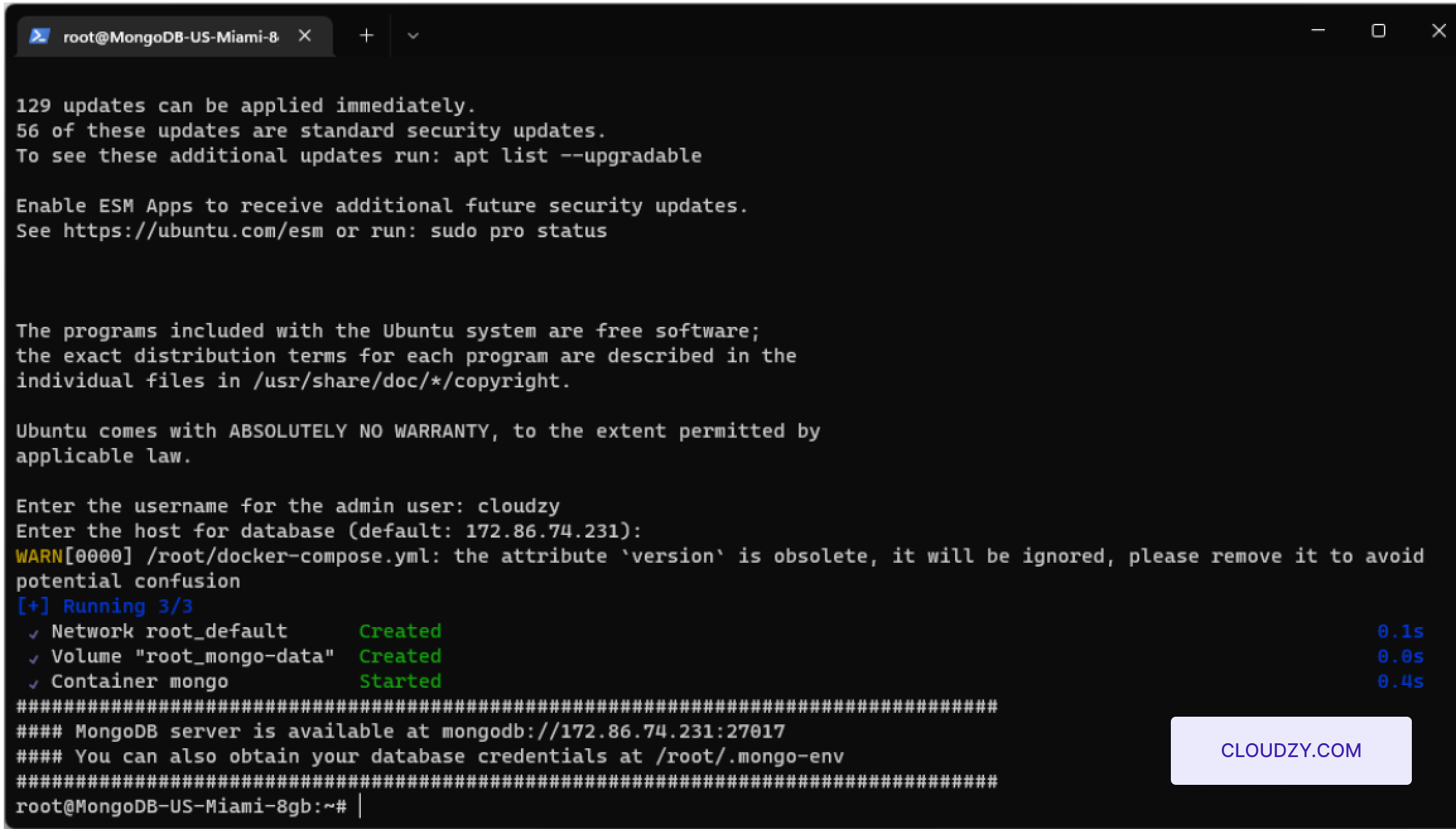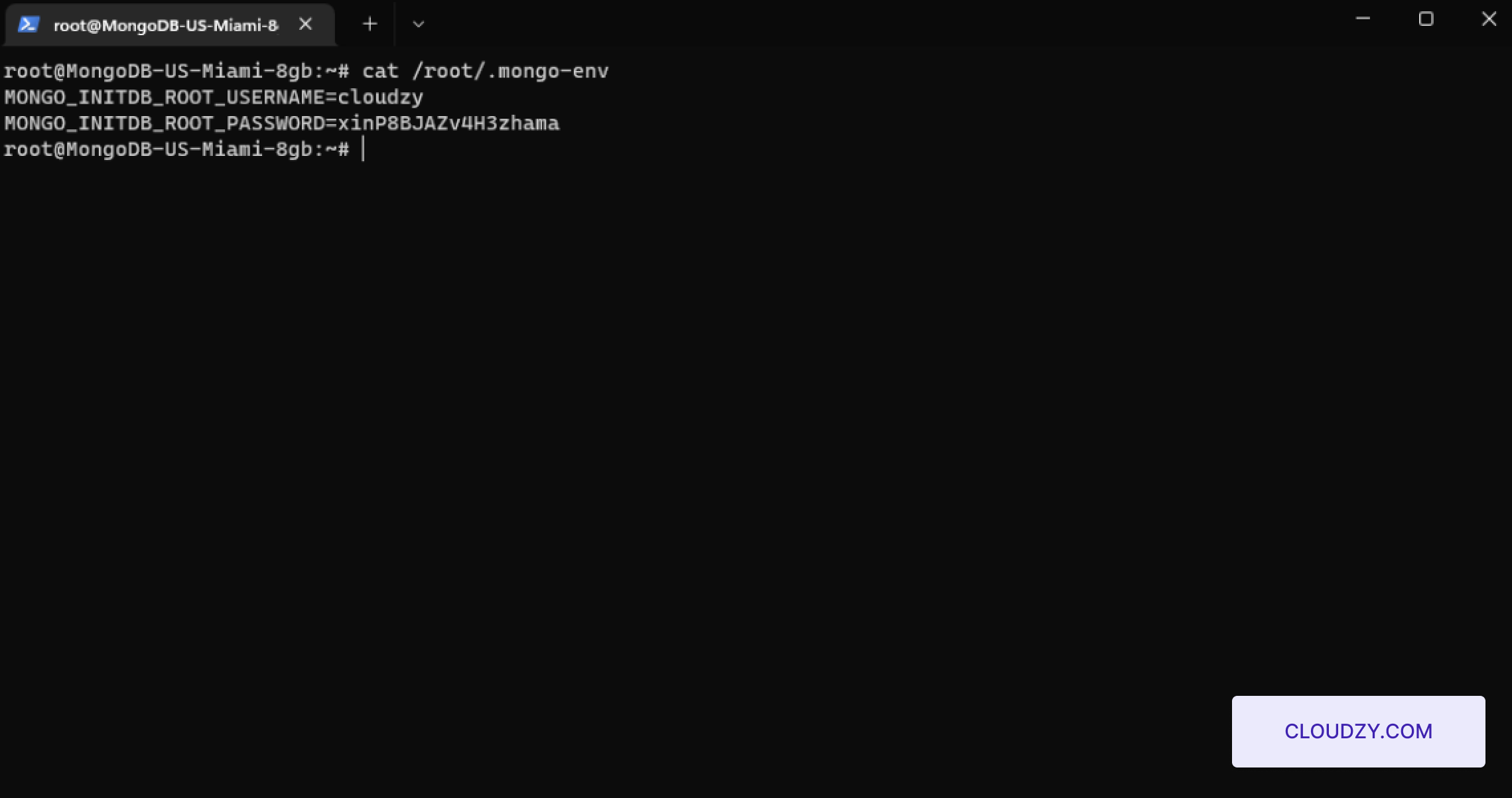This guide provides a straightforward approach to deploying and
configuring MongoDB on a Cloudzy Virtual Private Server (VPS) using the
One-Click App service. It covers the necessary steps to quickly set up a
MongoDB server, from accessing the server and configuring settings to
retrieving database credentials. Follow these simple instructions to
efficiently start using MongoDB for your projects.
Prerequisites
Before you start deploying MongoDB on your Cloudzy VPS using the
One-Click App, make sure you have the following:
Enough Credit: Ensure your Cloudzy account has
sufficient credit to set up and use the MongoDB One-Click App.
Active Account: Your Cloudzy account should be
active and ready for use.
Operating System Compatibility: The MongoDB
One-Click App is compatible with Ubuntu. You can choose from Ubuntu
Server 20.04, Ubuntu Server 22.04, and Ubuntu Server 24.04 versions.
Step 1:
Selecting the MongoDB Application
-
Log into your Cloudzy account: Start by signing
into your Cloudzy dashboard using your credentials. -
Navigate to the Applications section: On the
left side menu, click on ‘Applications’ to view the available
applications.

- Choose MongoDB: Among the various applications
listed, find MongoDB. You can use the search bar or scroll through the
list. Once found, click on ‘Deploy Service’ below the MongoDB icon.

- Select the operating system version: Choose the
appropriate version of Ubuntu (20.04, 22.04, or 24.04) for your MongoDB
application. This ensures compatibility and optimal performance.

This will prepare your system for the MongoDB installation with the
settings you need for a successful deployment.
Step 2:
Configuring Your VPS Settings
Before completing your order, you must create an account. To do this,
fill out the registration form with your name, email address, and a
strong password. You can also sign up with your Google account by
selecting the Continue with Google option.
- Select a Service Plan:
After choosing MongoDB and its compatible operating system, you’ll be
taken to the service configuration page. Review the VPS plans available,
each differing in vCPUs, memory, bandwidth, and storage capacity. For
MongoDB, opt for a plan with more memory and CPU resources to ensure
better performance.

- Set Up SSH Key (Optional but Recommended):
To enhance security, consider adding an SSH key for secure server
access.

If you don’t have an SSH key, it’s advisable to create one for
secure, password-less access. For guidance on how to configure and use
SSH keys, refer to Cloudzy’s SSH key setup guide. Cloudzy’s
SSH key setup guide
- Enter a Hostname:
Assign a hostname for your VPS, which serves as your server’s network
identifier.
Choose a meaningful hostname that reflects the server’s purpose, like
mongodb-server-01.
- Deploy Your VPS:
Once all configurations are confirmed to your satisfaction, click on
the ‘Deploy Now’ button to start the VPS provisioning process.  The setup will begin, and your server will
The setup will begin, and your server will
be prepared with MongoDB installed.
This process ensures that your MongoDB server is properly configured
with the necessary resources and security measures tailored to hosting a
database efficiently.
Step 3:
Monitoring the Deployment Process
- Track the Deployment Progress:
After clicking ‘Deploy Now’, you will be redirected to a status page
where you can monitor the deployment process of your VPS. This page
displays various stages such as ‘Preparing Network’, ‘Preparing Disk’,
‘Initializing’, and finally ‘Active’. Each stage gives you insights into
what is currently happening with your server setup.

- Deployment Completion:
The progress bar will indicate when each stage is completed. Wait for
all stages to reach the ‘Active’ status, which signifies that your
MongoDB server is fully deployed and operational.
This process might take a few minutes depending on the selected
configurations and network speed.

- Access Server Details:
Once the deployment is successful and the server status shows
‘Active’, you will receive information such as the server’s IP address,
username, and initial password.

Note down these details carefully. You will need them to access your
MongoDB server.
Completing these steps ensures that your MongoDB server is up and
running. You can now connect to your server using the provided
credentials to start using MongoDB for your applications.
Step 4:
Accessing and Using Your MongoDB Server
- Connect to Your Server:
Use the IP address, username, and initial password provided at the
end of the deployment process to connect to your server. If you need
help connecting via SSH, refer to Cloudzy’s
SSH connection guide. If you don’t have enough credit, a Low
Balance pop-up will show up, and you can click on Add
to Credit.
- Initial Setup of MongoDB:
After logging into your server, proceed to configure your MongoDB
instance.
Enter the Admin Username: When prompted in the
command line, input your chosen admin username. This username will be
used to manage your MongoDB environment.
Specify the Database Host: You will be prompted to
enter the host for your MongoDB database. If a default IP is suggested
and it suits your setup, you can accept it, or enter a different one as
required.

- Confirm Installation and Access Server:
Upon completion of the initial setup, the system will confirm that
your MongoDB server is operational, typically indicating an accessible
URL like mongodb://your-server-ip:27017. Replace your-server-ip with the
actual IP address provided.
- Access Database Credentials:
To view your MongoDB database credentials, use the command line to
navigate to the credentials file. Enter the following command:
cat /root/.mongo-envThis command will display the database credentials stored in the
.mongo-env file, including the MongoDB username and password.

By following these steps, your MongoDB server will be configured with
an admin user and prepared for database operations. This setup ensures
that your server is fully operational and secure for immediate use.